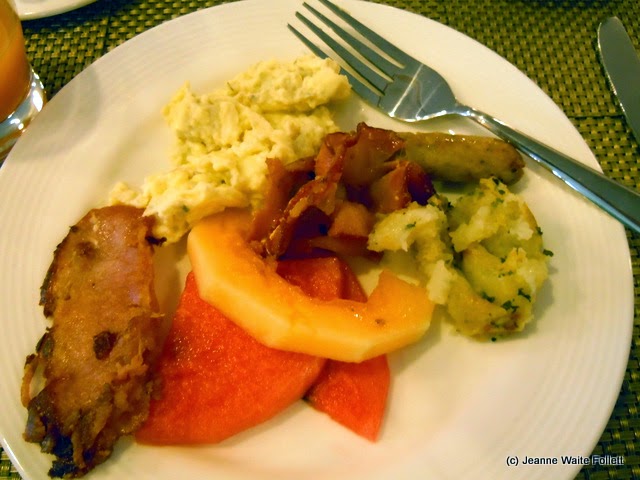Ch. 9, Morning in
Kolkata
Perhaps in return for conquest, arrogance and spoilation,
India will teach us the tolerance and gentleness of the mature mind, the quiet
content of the unacquisitive soul, the calm of the understanding spirit, and a
unifying, a pacifying love for all living things.—Will Durant
Whatever Hindu deity oversees promptness, schedules, and
similar ilk must have had good laugh at the expense of the humans who devised the
itinerary for our city tour of Kolata on Sunday, the 4th of
January. “Kolkata”, by the way, is the
preferred spelling of Calcutta. My
preference.
Is there such a deity
in Hinduism? Well, with 330 million,
there has to be room for that one, doesn’t there?*
Everything starts out right on schedule. Breakfast goes off without a hitch and the
country boat delivers us to the dock, where the guides lead us to the three
buses that will drive us through Kolkata, but not, however, before I make an
observation.
I’m sitting on a bench seat near the front of
the country boat and looking around at the various other boats in the river as
we motor to the dock. A large white boat catches my attention. I tap the fellow from Haimark and say, “That
boat over there has the same name as ours.”
 |
| R/V Ganges Voyager. Did I mention I needed more sleep? |
“That IS our boat!” he says. Then, as I lay my head on my arm, he
announces to the boat that I’ve won the best joke of the day. I love it when I do stuff like this.
Now we get to see in the daylight what had scared the
bejeepers out of us in that pell-mell dash through narrow, crowded, dark streets
the previous evening. It is just as
scary in daylight, but for one thing:
traffic is so heavy the bus can seldom manage to accelerate to a 50 mph
plunge through rickshaws, taxis, bicycles, buses, and pedestrians for any
sustained period. The incesssant beeping, however,
is even more overwhelming.
 |
| Sidewalk produce markets. |
 |
| Hauling steel reinforcing rod. If you can fasten it to the bike and trailer, they'll haul it. |
Shopkeepers legal and not, are tending their wares, homeless
are sleeping along the road, dogs curl up for naps in the road, and the sacred
cows do whatever they want to do. I see
merchants sweeping the areas in front of their business stalls, moving the
liter from the previous day’s activities into piles that grow exponentially day by day.
 |
| Note the condition of the two propane bottles. |
This is Sunday, the traditional bathing day, and men in
various stages of undress, but never naked, perform their ablutions and wash
their clothing at pumps and taps on the “sidewalks.”
 |
| Electrical wiring. |
 |
| Washing dishes. |
Eventually, after driving past this famous building and that
famous building from the British Colonial era, the bus pulls to the
curb on a fairly nondescript, tree-lined street in a less-impoverished part of town, a bit
more built up and a bit cleaner. A
tidy, three-story gray building with brown shuttered windows bears a sign:
We walk down a narrow alleyway and into the Mother House of
the Missionaries of Charity.
Inside, to
the right, a sister is arranging marigold petals on Mother Teresa’s tomb to
spell “the wise still seek him.” I recognize the room immediately as I’ve seen
two photographs taken in this room, as my friends Cap and Patti each have
photos of themselves with Mother Teresa in this humble spot.
Next to this room, a
simple chapel where photos are not allowed.
 |
| Mother Teresa's tomb, and an accidental shot of the chapel beyond, and the museum behind the partitions. |
Mother Teresa’s private bedroom is at the top of a flight of
stairs.
A brown and white plaid spread
covers her narrow bed in the small room.
Across from the bed a rustic table of unfinished wood with two benches
is against the wall. A small desk sits
under a window.
A sign requested that no photos be taken of her room, and I did not. I did, however, find numerous photos online. Below is one of them.
 |
| Could not find a credit for this photo from the internet. |
 |
| Standing outside Mother Teresa's bedroom, looking down at the courtyard. |
 |
| In a corner of the courtyard. |
After visiting the museum that contains many of Mother
Teresa’s belongings and memorabilia, we exit the Mother House, passing a sign
that requests we not give to, and thus encourage, any beggars nearby. And are promptly met by beggars.
We board the bus, expecting our next visit will be the
Missionaries of Charity orphanage.
Instead, our guide advises that a Muslim parade is coming up the street
and we must move or chance being stuck there for hours. We look out the back of the bus and see a
large crowd marching in the middle of the street a couple blocks away.
So move we do.
 |
| Hard to get a decent photo when the subject is on the opposite side of the bus thats careening around a corner. The hand MIGHT be an Indian mudra, prominent in yoga, Indian dance and art. This one might be the Varada Mudra, symbolizing the act of giving, in love and benevolence. I think that rather than a tree, this is a form covered in vegetation. See: http://online.wsj.com/public/resources/documents/DIALmudras.pdf |
(*Hinduism believes in only one God but allows its followers
to worship the God in many forms such as nature (including trees, sun, idols,
animals, etc.) and persons (Lord Krishna, Lord Rama, Lord Shiva, Lord Vishnu,
etc.). These persons are called devas (deities) and are often confused by
calling them gods. The figure 330,000,000 is a poetic
expression.)













































